Many ancient cultures worshipped solar deities. Such sun gods tended to be humanised in that they had emotional responses to events and often had back stories involving emotional interactions with other gods or humans.
Some cultures assigned more than one god to representing the sun such as the Egyptians who had Khepri for the rising sun, Atum (or Aten) for the setting sun, and Ra who would ride across the sky at noon. Although the majority of sun gods were male (forming a dichotomy with the often feminised moon), this wasn’t always the case as there were some sun goddesses. I have given an overview of ancient sun deites below and then, afterwards, given more detailed descriptions of the solar cults I believe to have been of most historical importance.
| Name of deity | Religion or culture |
|---|---|
| Arinna / Hebat | Syrian |
| Apollo | Roman |
| Chicomecoatl (goddess often depicted holding the sun as a shield) |
Aztec |
| Hindu | |
| Helios (Helius) | Greek |
| Hepa (also assimilated with Arinna) | Hittite |
| Huitzilopochtli (main Aztec sun god, who fought for leadership with the god Tonatiuh for power) |
Aztec |
| Hvar Khshaita (before Mithras) | Persian |
| Inti | Inca |
| Liza | West African |
| Mithras | Iranian/Persian |
| Re / Ra (also assimilated with Amun,/ Aten) | Egypt |
| Sol (Sunna) | Norse |
| Sol Invictus (a later Roman sun god, often a name used for Mithras) |
Roman |
| Surya | Hindu |
Aztec worship of the sun
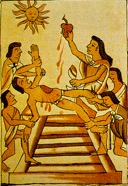
Sacrifice and cyclicality formed central elements in Aztec worship of the sun[1]. They believed that the correct offerings needed to be performed for the gods so as to ensure the rising of the sun and the continuation of life. These offerings varied from food and animals to human sacrifices. Some scholars believe that over twenty thousand people were sacrificed throughout the Aztec era!
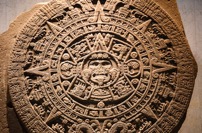
The cult of Re
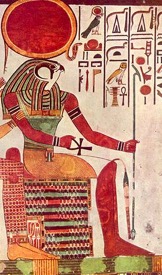
Re was typically portrayed as a falcon with the solar disk upon his head. The god could also be depicted as just a solar disk encircled by a protective cobra. Egyptian gods were changeable in their physical appearance, and Re was no exception. His forms included Khepri (a scarab beetle), which he supposedly embodied in the mornings, Re at midday and, in the evening, Atum (or Aten) who was a ram-headed god who would carry the sun over the horizon. The centre of Re’s worship was the city of Heliopolis.
As I wrote in the ‘Myth and Folklore’ section of this website, the Egyptian “Origin myth” features Re/Ra with regards to the belief that he rose from the ocean of chaos which surrounded the primeval hill. After creating himself, he then created the other gods. Many snycretisms were made of Re by Egyptians throughout their cultural time frame, as such he can be identified under several names including: Amon-Re, Re-Herakhty and Sebek- Re.
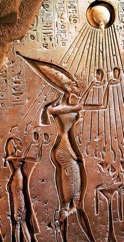
Although the sun god was continually worshipped by Egyptians, the most distinctive period of Egyptian sun worship came during the Amarna period (c.1350 – 1335 BCE) under the pharaoh Akhenaten. During this period, Akhenaten reduced the traditional array of deities to one, all-powerful god: Aten, the sun god.. This radical monotheism can be seen in tomb engravings and sculptures of the period, in which the sun, solar worship and attributes of the sun (such as sun rays and bright colours such as red and orange) dominate artistic subject matter.
The cult of Helios
Greek worship of the sun was manifested in reverence of the god Helios and, as the god of light, Apollo. Helios best exemplifies a recurring characteristic of sun gods throughout history: the riding of a chariot or boat. Helios rides his chariot across the sky each day, pulled by the horses Pyrois, Aethon, Phlegion and Aeos. It is in this riding of the chariot that Helois was thought to pull the sun, thus creating the sun’s daily rise and fall in to night.
Helios was thought to be the offspring of the titan Hyperion and titaness Theia, and as such was a titan himself. There is debate regarding the prominence of the cult of Helios. It is thought that worship of Helios was strong amongst pre-Hellenic Greek culture, but that the strength of of this worship declined in later periods. It is unclear how different geographical areas of Greek rule worshipped Helios – as different parts seem to give the god varying levels of importance. It seems that the island of Rhodes was one place were Helios was given an important cult, as can be ascertained from the Colossus of Rhodes – a giant staute of Helios supposedly once situated in the bay of Rhodes, although the truth of its existence, as well as the details of its stance, material and size, is unclear.
Helios is most famous for the story regarding his son, Phaeton, which – as I spoke about in the myths section of this website – bares similarities with the myth of Icarus. The repetition of this narrative and the emphasis placed by Greek and, subsequently, Roman culture, on the notion of hubris finds reflection in real life tragedies such as the many shipwrecks which plagued the Greek and Roman era as well as the rise and fall of figures of political power. Helios is also, at times, referred to as Sol.
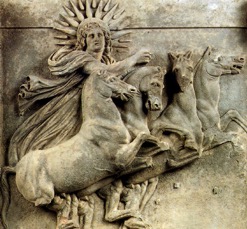
The cult of Mithras
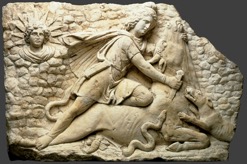
The cult of Mithras – a Roman deity who appears in historical records in the late 1st century CE until around the 4th century CE – was a major Roman, all male cult, particularly popular with freedmen. Mithras’s temples were always in an underground space, such as a cave, and would feature a relief of Mithras sleighing a bull.
The myth from which the cult stems was made form various literary texts as well as from images in temples. The myth starts with Mithras being born from a rock. After killing a bull, he meets the sun who bows down to him. It is this interaction with the sun in which I am most interested as I think it shows how man’s desire to dominate nature is deep-rooted in the history of many cultures.
After bowing to him, it is said that the sun and Mithras shook hands and ate a selection of bull parts. There are certain ancient monuments which show additional episodes of the myth, but it is this interaction with the sun which most defines Mithras as a deity and idol of worship. Such additional episodes include paintings at Dura Europos,, which follow a strange sequence starting with Jupiter fighting against the giants, then a bearded man lying on a rocky surface (a man who might be Oceanus). These unusual scenes precede the classic Mithras sun myth.
[1] The Aztec Solar Calendar is a fascinating artistic and cultural device. One of my favourite books on the subject is Randel Jimenez’s The Aztec Calendar Handbook – I’d recommend anyone who wants a more detailed understanding of the object to read it.